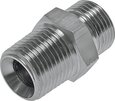Hydraulic Fitting Types and Applications
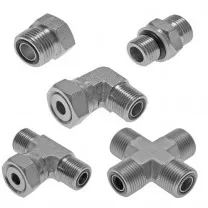
Figure 1: ORFS hydraulic fittings
Hydraulic fittings connect a hydraulic hose to components like hydraulic cylinders, pipes, tubes, or different types of hydraulic hoses in hydraulic systems. They come in a wide range of types for various applications. The different types of hydraulic fittings allow the fluid to flow, change its direction, divert, or mix. These fittings should be capable of creating a tight seal and preventing leakage in the application.
- Choose ORFS Fittings for high-pressure applications requiring a leak-free connection with an o-ring face seal.
- Choose JIC Fittings when you need durable, easy-to-assemble fittings with 37° flare seating surfaces for high-pressure use.
- Select ISO Hydraulic Fittings to ensure compliance with industry standards, focusing on specific applications like agriculture or chemical industries.
Table of contents
- ORFS fittings
- JIC fittings
- ISO hydraulic fittings
- Selection criteria
- How to properly connect to a hydraulic hose
- Hydraulic fitting charts
- FAQs
View our online selection of hydraulic fittings!
ORFS fittings
ORFS (O-Ring Face Seal) fittings have an o-ring groove at the flat face of the fitting. These fittings are ideal for high-pressure applications and provide a leak-free connection. These fittings have the following specifications and are discussed in Table 1.
- Connection type: Inner thread flare (UNF), outer thread conical (NPT), outer thread cylindrical (BSPP-G), Outer thread flare (UNF), and outer thread metric.
-
Max pressure at 20 °C (bar): 250, 400, and 630 (straight, tee, and cross)
- The elbow type has fittings for 200, 250, 315, 400, and 630 bar.
-
Max pressure at 68 °F (psi):3,626, 5,801, and 9,137 (straight, tee, and cross)
- The elbow type has fittings for 2,901, 3,626, 4,569, 5,801, and 9,137 psi.
- Fitting features: All ORFS fittings have a gasket. These fittings can also have reducers or bulkhead features.
- Reducer: Used to connect hydraulic connections of different sizes.
- Bulkhead: Used to connect hydraulic connections with a barrier between them (e.g., a metal panel)
Table 1: Types of ORFS fittings
| Type of fitting | Description | Image |
| <a html="/collections/straight-orfs-fittings">Straight ORFS fitting</a> | Straight screw connection with male ORFS connection point to male NPT, G or metric threads | 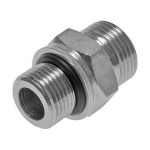 |
| <a html="/collections/elbow-orfs-fittings">Elbow ORFS fitting</a> | Elbow screw connection with one ORFS female connection and another ORFS male connection at an angle | 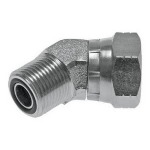 |
| <a html="/collections/tee-orfs-fittings">Tee ORFS fitting</a> | T- shaped screw connection with one female ORFS connection port and two male ORFS connection ports | 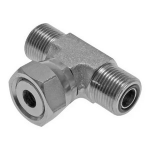 |
| <a html="/collections/cross-orfs-fittings">Cross ORFS fitting</a> | Four male ORFS connection ports in a cross-orientation, useful for distributing or combining the media | 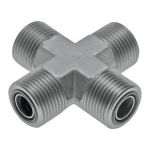 |
JIC fittings
JIC fittings, or Joint Industry Council fittings, are known for their 37° flare seating surfaces, which provide reliable, leak-proof seals. These fittings are commonly used in high-pressure applications and are valued for their durability and ease of assembly and disassembly. These fittings have the following specifications:
- Connection type: Inner thread conical (NPT), inner thread cylindrical (BSPP-G), inner thread flare (UNF), outer thread cylindrical (BSPP-G), outer thread flare (UNF), outer thread metric, and outer thread JIC.
- Body material: Steel and stainless steel
- Seal material: FKM, NBR, HD-seal, soft seal
- Max pressure at 20 °C: 75 to 450 bar (1090 to 6525 psi)
-
Fitting features
- Reducing: See explanation in ORFS fittings section
- Adjustable: These JIC fittings have a lock nut feature that provides a tighter, more secure connection.
- Model: T-piece and L-shape (45° and 90° bend)
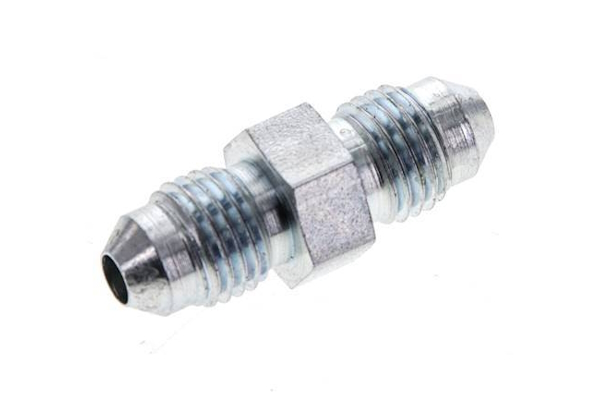
Figure 2: A JIC fitting with flared seating surfaces.
ISO hydraulic fittings
Several ISO standards cover various hydraulic fittings. Standards like ISO are important because they ensure quality, safety, and consistency across industries.
-
ISO 7241: This standard outlines the interface dimensions and basic performance standards for two types of hydraulic quick-action couplings, both widely used and technologically similar.
- ISO 7241 A: Series A is mainly used in Europe and is favored globally for agricultural and forestry machines.
- ISO 7241 B: Series B is mainly used in North America and the chemical industry.
- ISO 16028: This standard defines the interface dimensions and performance standards for flat-face hydraulic quick-action couplings used at pressures from 100 bar to 315 bar, depending on size. These couplings are designed to prevent fluid leaks when disconnected, but they must be disconnected only when the system is not pressurized.
- ISO 14540: This standard defines size and performance standards for hydraulic screw-to-connect couplings used at 72 MPa (720 bar) pressure, typically connecting a hydraulic power unit to a tool. For example, hydraulic jacks, rams, clamping devices, hand tools, and cylinders.
- ISO 14541: This standard defines the dimensional and performance requirements for hydraulic screw-to-connect quick-action couplings for general use.
Selection criteria
Consider the following criteria before selecting the correct hydraulic fitting types for your application:
- Material: The material of the hydraulic fitting should be compatible with the hydraulic fluid and the operating environment. The most commonly used fitting materials are brass, plastic, steel, or stainless steel. NBR is the most common material for o-ring seals.
-
Connection size: Connection size depends on the connection type:
- Threaded: Inch or metric (e.g., 1 inch or M16 x 1.5)
- Cutting ring connection: Cutting ring connections for these fittings range in size from 8 mm to 30 mm.
- Nominal diameter: This indicates the approximate inner diameter of the coupling's passage through which the fluid flows. It is a standardized size designation that helps ensure compatibility and interchangeability between different components in a hydraulic system.
- Max pressure at 20 °C (bar): Selecting the right maximum pressure for a hydraulic coupling ensures safety, optimal performance, durability, system integrity, and compliance with industry standards.
FAQs
What are hydraulic fittings?
Hydraulic fittings connect hoses to components like cylinders or pipes, allowing fluid to flow, change direction, divert, or mix.
Do you use Teflon tape on hydraulic fittings?
No, Teflon tape should not be used on hydraulic fittings. Hydraulic fittings usually seal on the thread or through the use of an o-ring.
How to install hydraulic hose fittings?
Select the right fitting, cut the hose to length, insert it into the fitting, crimp it, and clean the assembly to prevent debris from entering the system.
How to seal hydraulic fittings?
Hydraulic fittings are either self-sealing, such as SAE flanged fittings, sealed by using an o-ring, or through the use of thread sealant.




